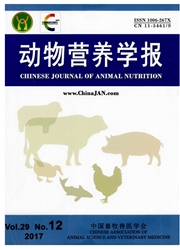

 中文摘要:
中文摘要:
本试验旨在利用过氧化氢(hydrogen peroxide,H2O2)作为刺激源,以细胞存活率及抗氧化指标为判断指标,建立奶牛乳腺上皮细胞( bovine mammary epithelial cells,BMEC)的氧化损伤模型。试验一采用单因子完全随机试验设计,将第3代贴壁生长的BMEC随机分为42组,每组10个重复。细胞培养液中分别添加0、100、200、400、600、800和1000μmol/L H2O2,使之分别作用2、4、6、8、12、24 h,测定细胞数量,计算存活率。试验二是在试验一得出的适宜H2O2作用时间(本试验的结果为6 h)的基础上,采用单因子完全随机试验设计,将第3代贴壁生长的BMEC随机分为7组,每组6个重复,BMEC中添加不同浓度的H2O2(0、100、200、400、600、800和1000μmol/L)作用细胞6 h,收集细胞和培养液测定抗氧化指标,筛选使细胞发生氧化损伤的适宜H2O2作用浓度。试验一结果表明,600μmol/L H2O2作用细胞6 h,BMEC的存活率降低至79.79%。试验二结果表明,600-1000μmol/L组与其他各组相比均显著降低了谷胱甘肽过氧化物酶、超氧化物歧化酶和过氧化氢酶活性,提高了丙二醛含量(P〈0.05),但600、800和1000μmol/L组之间差异不显著( P〉0.10)。结果提示,H2O2作用浓度为600μmol/L、作用时间为6 h,使BMEC产生了明显的氧化应激,可作为建立细胞氧化损伤模型时的适宜条件。
 英文摘要:
英文摘要:
This study was conducted to establish the oxidative damage model of bovine mammary epithelial cells (BMEC) using hydrogen peroxide (H2O2) as stress source and using survival rate and antioxidant pa-rameters as judgment indices. Experiment 1 was conducted as a single factor randomized arrangement, and the 3rd passage BMEC were divided into 42 groups with 10 replicates in each group. Cells were incubated in differ-ent concentrations of H2O2 (0, 100, 200, 400, 600, 800 and 1 000 μmol/L,respectively) for 2, 4, 6, 8, 12 and 24 h, respectively. The cell count was determined, and the survival rate was calculated. On the basis of experiment 1 ( optimal action time was 6 h ) , experiment 2 was also conducted as a single factor randomized arrangement, and the 3th passage BMEC were divided into 7 groups with 6 replicates in each group. Culture mediums containing different concentrations of H2O2 (0, 100, 200, 400, 600, 800 and 1 000 μmol/L, re-spectively) were used to act cell for 6 h. The cells and culture mediums were collected for the analysis of an-tioxidant parameters to select the appropriate concentration of H2O2 ensuring oxidative damage to cells. The re-sults showed as follows: experiment 1, the BMEC survival rate reduced to 79. 79% when the cells were in-duced by 600 μmol/L H2O2 for 6 h. Experiment 2, cell induced by 600 to 1 000 μmol/L H2O2 significantly decreased the activities of glutathione peroxidase, superoxide dismutase and catalase (P〈0.05), and signifi-cantly increased malondialdehyde content compared with the other groups (P〈0.05), but the differences a-mong 600, 800 and 1 000 μmol/L groups were not significant (P〉0.10). The condition that 600 μmol/L H2O2 reacted for 6 h is optimal for establishment of oxidative damage model in BMEC.
 同期刊论文项目
同期刊论文项目
 同项目期刊论文
同项目期刊论文
 Effects of vitamin A on the milk performance, antioxidant functions and immune functions of dairy co
Effects of vitamin A on the milk performance, antioxidant functions and immune functions of dairy co Effectsof retinoic acid on synthesis of selenoprotein and antioxidative indices ofbovine mammary epi
Effectsof retinoic acid on synthesis of selenoprotein and antioxidative indices ofbovine mammary epi 期刊信息
期刊信息
